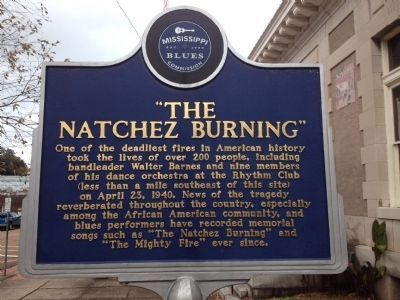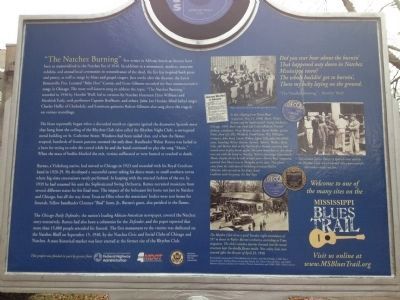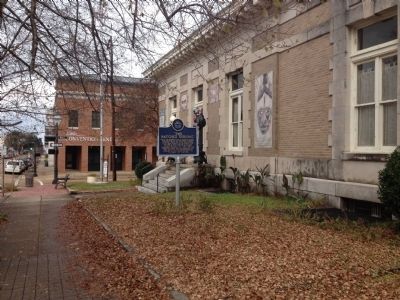Natchez in Adams County, Mississippi — The American South (East South Central)
"The Natchez Burning"
One of the deadliest fires in American history took the lives of over 200 people, including bandleader Walter Barnes and nine members of his dance orchestra at the Rhythm Club (less than a mile southeast of this site) on April 23, 1940. News of the tragedy reverberated throughout the country, especially among the African American community, and blues performers have recorded memorial songs such as “The Natchez Burning” and “The Mighty Fire” ever since.
(side 2)
"The Natchez Burning" Few events in African-American history have been as memorialized as the Natchez fire of 1940. In addition to a monument, markers, museum exhibits, and annual local ceremonies in remembrance of the dead, the fire has inspired both prose and poetry, as well as songs by blues and gospel singers. Just weeks after the disaster, the Lewis Bronzeville Five, Leonard “Baby Doo” Caston, and Gene Gilmore recorded the first commemorative songs in Chicago. The most well-known song to address the topic, “The Natchez Burning,” recorded in 1956 by Howlin’ Wolf, led to versions by Natchez bluesmen Elmo Williams and Hezekiah Early, rock performer Captain Beefheart, and others. John Lee Hooker, blind ballad singer Charles Haffer of Clarksdale, and Louisiana guitarist Robert Gilmore also sang about the tragedy on various recordings.
The blaze reportedly began when a discarded match or cigarette ignited the decorative Spanish moss that hung from the ceiling of the Rhythm Club (also called the Rhythm Night Club), a corrugated metal building on St. Catherine Street. Windows had been nailed shut, and when the flames erupted, hundreds of frantic patrons stormed the only door. Bandleader Walter Barnes was hailed as a hero for trying to calm the crowd while he and the band continued to play the song “Marie.” When the mass of bodies blocked the exit, victims suffocated or were burned or crushed to death.
Barnes, a Vicksburg native, had moved to Chicago in 1923 and recorded with his Royal Creolians band in 1928-29. He developed a successful career taking his dance music to small southern towns where big-time entertainers rarely performed. In keeping with the musical fashion of the era, by 1939 he had renamed his unit the Sophisticated Swing Orchestra. Barnes recruited musicians from several different states for his final tour. The impact of the holocaust hit home not just in Natchez and Chicago, but all the way from Texas to Ohio when the musicians’ bodies were sent home for funerals. Fellow bandleader Clarence “Bud” Scott, Jr., Barnes’s guest, also perished in the flames.
The Chicago Daily Defender, the nation’s leading African-American newspaper, covered the Natchez story extensively. Barnes had also been a columnist for the Defender, and the paper reported that more than 15,000 people attended his funeral. The first monument to the victims was dedicated on the Natchez Bluff on September 15, 1940, by the Natchez Civic and Social Clubs of Chicago and Natchez. A state historical marker was later erected at the former site of the Rhythm Club.
Erected 2008 by the Mississippi Blues Commission. (Marker Number 36.)
Topics and series. This historical marker is listed in these topic lists: African Americans • Arts, Letters, Music • Disasters • Entertainment. In addition, it is included in the Mississippi Blues Trail series list. A significant historical month for this entry is April 1920.
Location. 31° 33.652′ N, 91° 24.242′ W. Marker is in Natchez, Mississippi, in Adams County. Marker is at the intersection of Main Street and North Wall Street, on the right when traveling north on Main Street. Touch for map. Marker is in this post office area: Natchez MS 39120, United States of America. Touch for directions.
Other nearby markers. At least 8 other markers are within walking distance of this marker. Intersection of Main and Wall streets (within shouting distance of this marker); Site of Bank of Mississippi (within shouting distance of this marker); Intersection of Main and North Pearl streets (about 300 feet away, measured in a direct line); Commercial Bank Building (about 300 feet away); Andrew Marschalk (about 400 feet away); Bud Scott (about 400 feet away); Intersection of Main and Canal Streets (about 400 feet away); United States Courthouse (about 400 feet away). Touch for a list and map of all markers in Natchez.
Related marker. Click here for another marker that is related to this marker.
Also see . . . Mississippi Blues Trail. (Submitted on December 19, 2013.)
Credits. This page was last revised on August 30, 2017. It was originally submitted on December 17, 2013, by Robert M. Cook, Jr. of Biloxi, Mississippi. This page has been viewed 1,475 times since then and 86 times this year. Photos: 1, 2, 3. submitted on December 17, 2013, by Robert M. Cook, Jr. of Biloxi, Mississippi. • Bernard Fisher was the editor who published this page.


